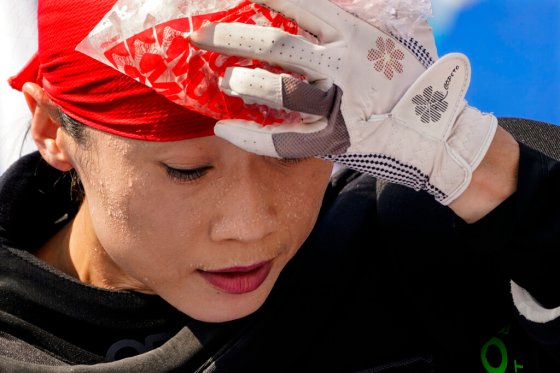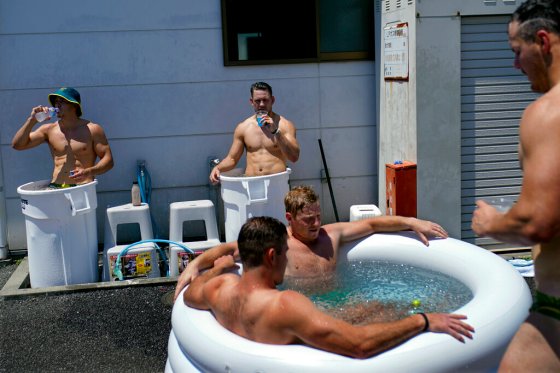New top story from Time: Everyone Knew Tokyo Would Be One of the Hottest Olympics Ever. It’s Still Taking a Brutal Toll
Australian kayaker Jo Brigden-Jones knew the heat at the Tokyo Summer Olympics would be intense. She prepared for the weather during training by biking in a heat chamber and sitting in a hot spa. But, the weather still took some getting used to, not least because it’s winter back home in the northeast Australian state of Queensland.
“The first couple of days, it felt like I broke into a sweat whenever I stepped outside,” she says. “And with the face masks, it’s a bit suffocating to breathe.”
Many Olympic athletes tried to prepare for the Japanese host city’s scorching summer. The Australian Institute of Sport, for instance, launched the Tokyo Heat Project to help Australian athletes prepare for the conditions in Tokyo. But the extreme weather is still taking a toll, creating potentially dangerous conditions at times as athletes push themselves to the limit in the quest for Olympic gold.
[time-brightcove not-tgx=”true”]
Temperatures have soared into the 90s Fahrenheit this week, putting the Tokyo Olympics in the running for one of the hottest on record. It’s also making already difficult conditions—athletes must maintain strict social distancing requirements and no spectators are allowed—even harder.
“The conditions in Japan are certainly very challenging, and it has been so important that athletes enter into that environment acclimated, ready to utilize cooling strategies and focused on maintaining hydration,” says Dr. Peta Maloney, physiologist and senior adviser for the Australian Institute of Sport’s Tokyo Heat Project.

How hot is too hot?
The mean temperature in Tokyo has climbed by 2.9 degrees Celsius (5.1 degrees Fahrenheit) since 1900, more than three times as fast as the world’s average, according to a report by the British Association for Sustainable Sport. The study, titled “Rings of Fire: How Heat Could Impact the 2021 Tokyo Olympics,” says that athletes are being asked to compete in environments that are becoming “too hostile” for the human body as climate change increases global temperatures.
The 2004 Athens Olympics were the hottest since 1964, with a maximum daily temperature of about 93.6 degrees, according to the report. The last summer Olympics, in Rio, had a max daily temperature of just under 92 degrees.
With the Japan Meteorological Agency forecasting high temperatures of more than 93.2 degrees next week, this year’s Olympics will come close to hitting the record, and may surpass it.
READ MORE: Team USA Just Had Its Biggest Day Yet in the Pool. And Caeleb Dressel Clinched the Marquee Gold
Brandon Aydlett, a lead meteorologist with the National Weather Service office in Guam, tells TIME that athletes won’t find much relief in the coming days. “When you have weak winds across the area that really makes the heat feel more oppressive, and also that humidity will become a little bit more burdensome on people.”
Maloney, of the Tokyo Heat Project, tells TIME that heat and humidity can have a significant impact on performance. “It’s not uncommon for athletes to experience a reduction in performance of up to 10%, especially if they arrive unprepared and unacclimated.”
She says that competing in high humidity can be particularly difficult, because as humidity rises, it becomes more challenging for the sweat to evaporate from the skin. “If the sweat simply drips off the body, it has no cooling effect and contributes to dehydration and a continual rise in body temperature,” she says.
July and August are the hottest months in Japan, and the last summer Olympics in the country in 1964 were held in October. Japan has faced criticism for describing the country’s weather “mild” and “ideal” during the bidding process; especially since Tokyo’s heat has proved deadly in past years. A heatwave in the summer of 2018 killed more than 1,000 people. In the last week of July 2019, dozens died and thousands were hospitalized. Last summer, Hamamatsu, a coastal city in Shizuoka Prefecture on the island of Honshu, tied a national temperature record of 106 degrees.
And, though it may be cold comfort, the heat athletes face is line with annual averages for Tokyo.

‘I can finish the match, but I can die’
The impact of the heat has been hard to miss for anyone watching the Olympics closely. At the Opening Ceremony, some athletes could be seen laying in the humidity on the stadium floor during the Parade of Nations, checking phones, seemingly exhausted after just walking through the stadium.
On the day of the Opening Ceremony, Russian archer Svetlana Gomboeva collapsed from heatstroke (she recovered to win a silver medal).
Spanish tennis player Paula Badosa left the court in a wheelchair on Wednesday after retiring from her quarterfinal match against Marketa Vondrousova, the Czech player who knocked Naomi Osaka out of the Games, because of heatstroke. A Russian player struggled to play in the hot and humid conditions (the heat index felt like it was about 99 degrees.) “I can finish the match but I can die,” Daniil Medvedev told an umpire, who asked if he could continue play.
After Medvedev, world No. 1 Novak Djokovic and other players lobbied for changes, the International Tennis Federation announced that beginning on Thursday, tennis matches would start at 3 p.m. local time instead 11 a.m. to protect athletes from the hottest part of the day.
Tennis players may be some of the most at risk athletes. The British Association for Sustainable Sport report cited tennis, hockey, triathlon and marathon—all requiring long exposure to the elements—as sports with a high risk of heat-related illness. In a concession to the heat, marathon and race walking events were moved some 500 miles north of Tokyo to the island of Hokkaido.
Read more about the Tokyo Olympics:
- Naomi Osaka: ‘It’s O.K. to Not Be O.K.’
- Motherhood Could Have Cost Olympian Allyson Felix. She Wouldn’t Let It
- Simone Biles’ Olympic Team Final Withdrawal Could Help Athletes Put Their Mental Health First
- ‘Unapologetic and Unafraid.’ Sue Bird Stares Down Olympic Glory in Tokyo and Equity Off the Court
- Meet 6 Heroes Who Helped Battle COVID-19 Before Competing in the Tokyo Olympics and Paralympics
- Here’s How Many Medals Every Country Has Won at the Tokyo Summer Olympics So Far
- 48 Athletes to Watch at the Tokyo Olympics
- The Olympic Refugee Team Was Created to Offer Hope. Some Athletes Are Running Away From It
In 2019, organizers of the Games launched the Tokyo 2020 Cooling Project to address the weather—proposing solutions like installing mist cooling stations and offering frozen desserts. A volunteer on the press operations team tells TIME that they’ve set up a shift system so she only needs to work outside for an hour at a time.
Athletes and onlookers are using a host of tricks to stay cool. Several athletes from Team Canada who came to watch the women’s street skateboarding event on July 26 brought a bag of ice along to keep themselves cool. One reporter covering skateboarding covered his head with an umbrella, as protection from the sun. Team USA flag bears wore battery-powered cooling jackets designed by Ralph Lauren to the Opening Ceremony.
Kayaker Brigden-Jones plans to try to stay in air conditioning between races, and use things like ice vests and baths and cold drinks to keep cool. Given the short length of her races (less than two minutes), she says she isn’t too worried about the heat.
Maloney cautions that coaches and others may also be at high-risk of suffering from heat. “It’s often the support staff and coaches that end up being out in the heat for the longest and are potentially less concerned with themselves,” she says.
Maloney says that prior heat acclimation is particularly important. “Without adequate preparation, athletes put themselves at greater risk of heat-related illness,” she says, “especially given we know athletes are highly motivated and willing to push themselves to the limit.”
—With reporting by Sean Gregory and Aria Chen/Tokyo.
Comments
Post a Comment